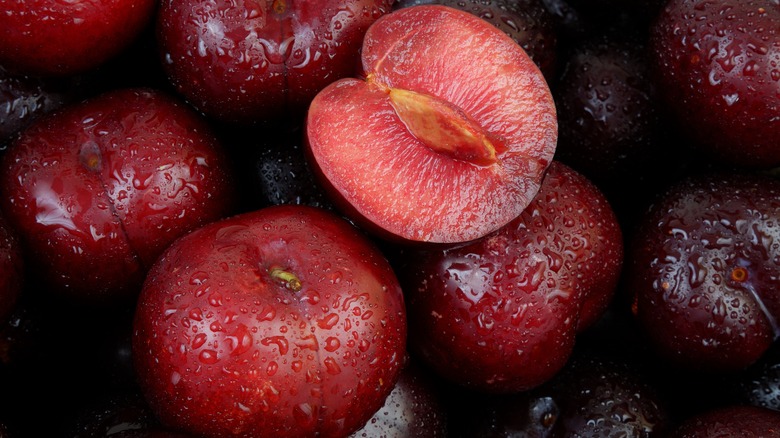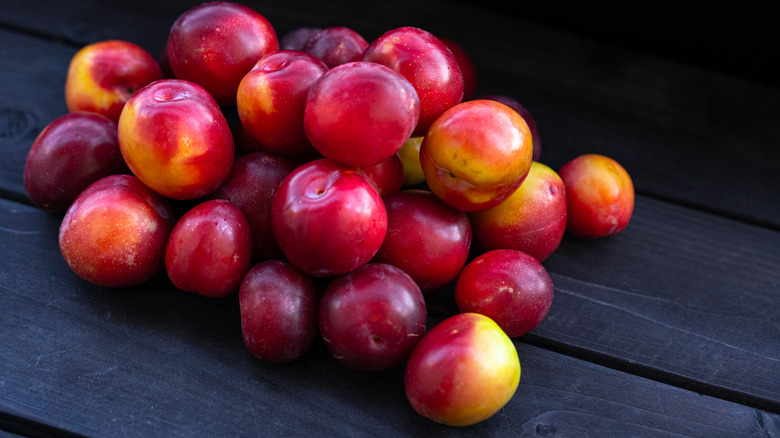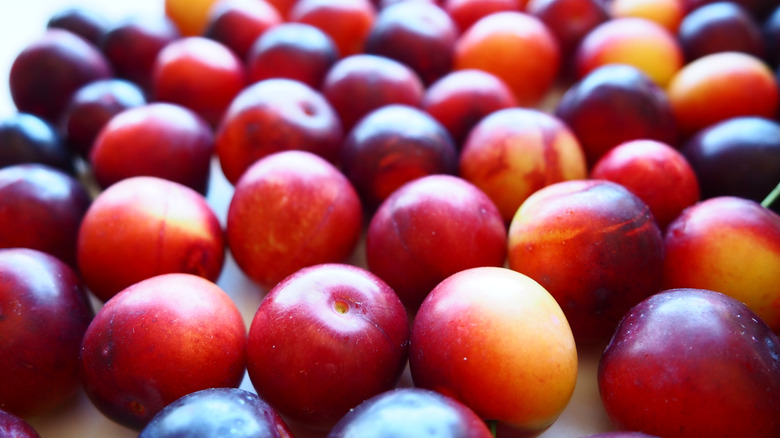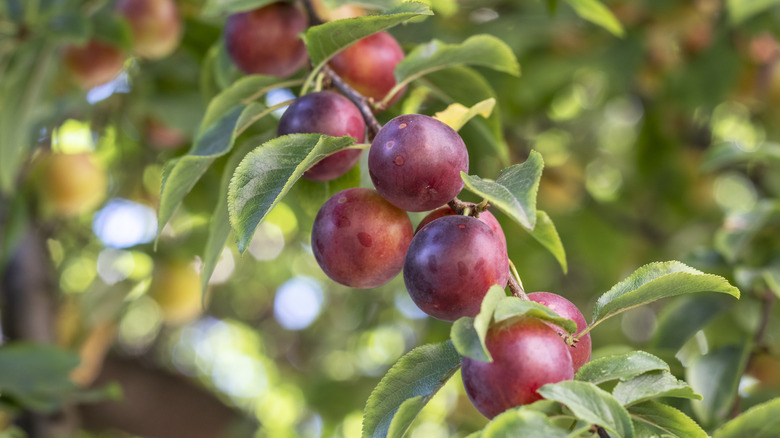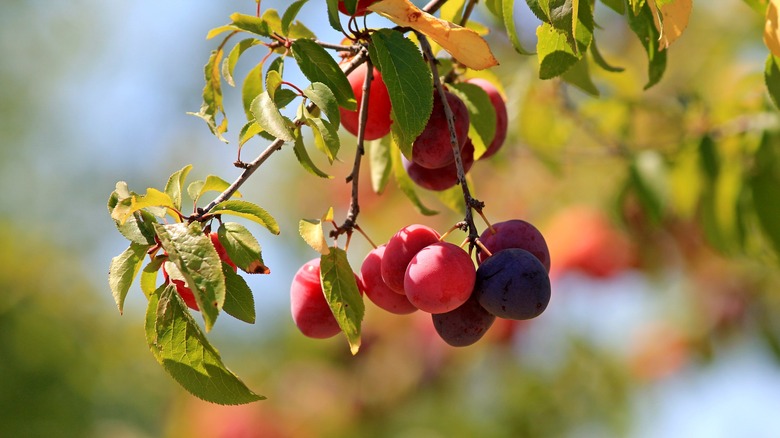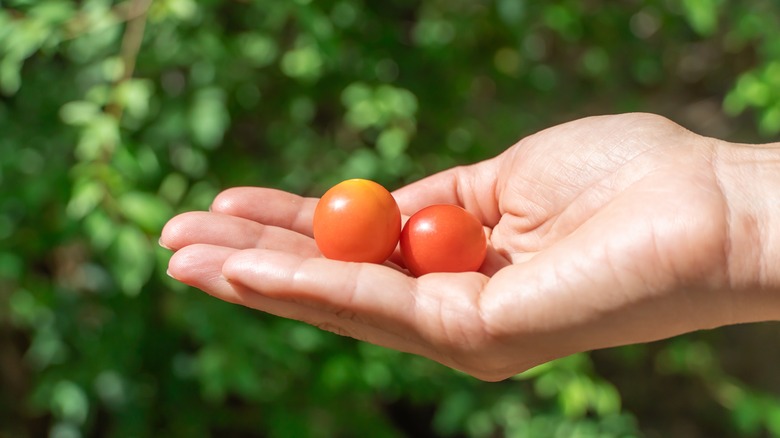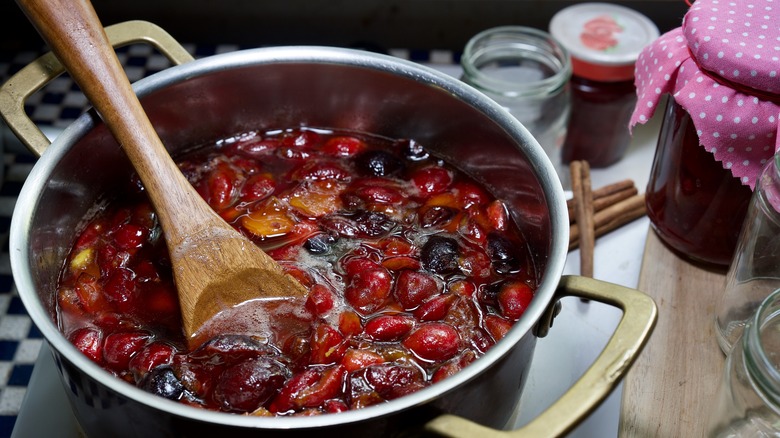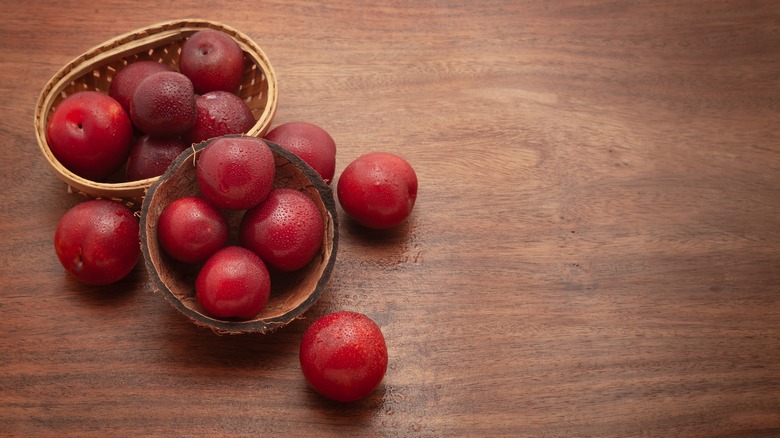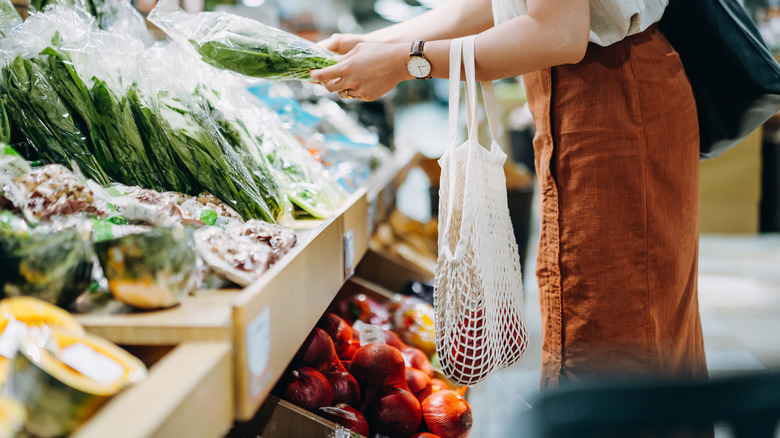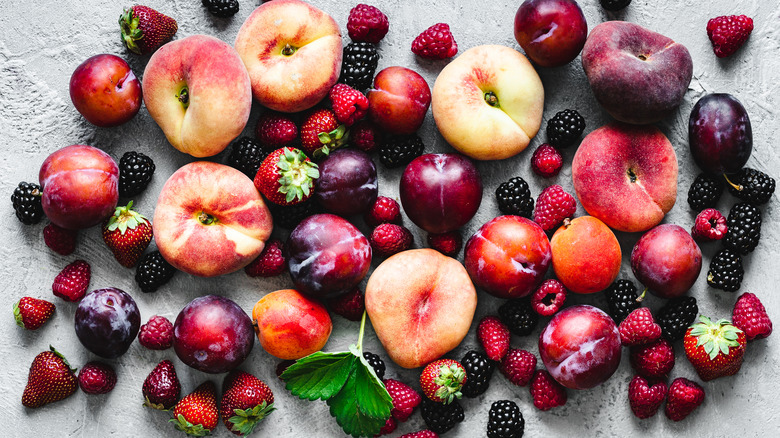Cherry Plums: What You Should Know About This Versatile Fruit
We may receive a commission on purchases made from links.
When you picture a plum, you'll most likely think about a dark, purple-skinned fruit with a sweet and mellow taste: most likely a damson plum. Whilst you may be familiar with a few more variations, sporting different hues and various sizes, there are actually more types of plum than you probably were aware of — each with their own unique taste, properties, and culinary applications. Amongst the lesser-known variations are cherry plums; a delicate and compact-sized plum that nevertheless packs a vibrant punch.
Indeed, though smaller and less widespread than their more commonly known cousins, these sweet and slightly tart plums are a fruit that belongs on your radar, lending themselves notably well to a vast array of culinary uses. For expert insight into just what makes cherry plums unique, we spoke to Karim Habibi, nursery manager at Keepers Nursery in Kent, England — home to the largest range of fruit trees in the UK. Habibi's knowledge of cultivating cherry plums provides useful insight into this underrated fruit.
So, we'll be covering everything you need to know about cherry plums, from how to eat to where (and crucially, when) to find them, as well as how and where they grow and how their distinct taste sets them apart from more common varieties of plums. If you're looking to bring a new lease of life to your recipes, this fruit might be the key ingredient you've been missing out on.
What are cherry plums?
Cherry plums, known botanically as prunus cerasifera, are a unique variety of sweet and small stone fruits that typically have glossy skins with vibrant shades of red and inviting golden tones. However, despite their name, cherry plums are, in fact, not a hybrid between cherries and plums. As Karim Habibi assures us, when it comes to classification, "They are basically plums; they're nothing really to do with cherries."
Their name, and with it any misconceptions, likely comes from the fact that cherry plums typically grow to about the size of a large cherry. Measuring between two to three centimeters across, cherry plums also possess an oval or round shape that is reminiscent of their namesake. For whilst some people may use the term "cherry plum" to refer to fruits that are the result of crossbreeding cherries and plums, prunus cerasifera have been growing naturally in the wild for centuries. They also boast a unique set of properties that set them apart from both cherries and more widely known types of plums.
Indeed, cherry plums are not the same as the plums you may often pick up at your local supermarket, with dark purple flesh and thick skins, instead possessing their own distinct flavor and an array of culinary uses, as previously mentioned. Their small size, juicy texture, and subtle tartness make them a useful and wholly tasty ingredient in an array of recipes.
How is this fruit different from regular plums?
One of the key differences between cherry plums and domestic plums that most people are more familiar with is the fruiting season of the plants, Karim Habibi explains. Cherry plum plants tend to flower earlier, some — including an Iranian variety — as early as February. This is considerably sooner than the more commercially available varieties of plums, whose trees flower a couple months later.
This early bloom means that fresh and ripe cherry plums are ready and available ahead of other types, typically in early summer. This is ideal if you are looking to cook with seasonal produce but are slightly premature in your search. They're one of the first fruits of the year that can be picked, Habibi tells us. He adds that this does, however, rely on a relatively warm February — which accounts for the cherry plum's popularity amongst foragers and enjoyers of locally grown and sourced wild foods.
Moreover, cherry plums have a taste that makes them distinct from other types of plums. More on this below, but with layers of complexity and nuance to their flavor profile, their taste is arguably unmatched by other variations. Cherry plums are also significantly smaller than most other types of plums, which not only makes them ideal for eating directly, but also means that they can be used whole in cooking or baking.
Where did cherry plums originate?
Although they can be found in numerous places around the world today, it's widely thought that cherry plums originated in Western Asia — including Iran's mountainous regions — and Southeastern Europe. Having grown naturally there for centuries, international trade eventually led to cherry plums becoming widely integrated into the remainder of both continents, particularly in the vast forest landscapes of Europe. This includes, as you may have guessed, the British Isles. Karim Habibi notes that some cherry plums can be found in hedgerows in the southeast of England, and they are popular amongst foragers, since they are easy to spot and can be eaten directly.
In more recent times, cherry plums have also expanded further into Australia and the U.S., aided by their adaptability and ability to grow in various climates and conditions. Habibi notes that they are also grown and sold as decorative plants thanks to their attractive and delicate blossom and early flowering — both of which are heavily associated with springtime aesthetics.
How are these plums grown?
Cherry plums grow on sturdy trees that generally attain a maximum height of eight meters. These trees, and by extension the plums themselves, are relatively easy to grow, able to thrive in almost all soils and requiring only a small amount of watering (unless they are being grown in notably dry conditions or if the plant is still very young). These plants require a significant amount of sun and fare best in areas that are shielded from the wind, but they can also grow successfully in areas with a little bit of shade.
As such, this is why cherry plums are grown around the world. They also do not require much extensive knowledge, with Karim Habibi noting that these plants are particularly popular amongst home gardeners. This is not only because of the tasty fruit they yield, but additionally on account of their aforementioned attractive appearance, depending on the exact type. He explains, "All plum trees have white blossom, but you can get pink cherry plum blossom, which ... looks quite nice."
What do cherry plums taste like?
Cherry plums offer a distinct flavor profile that sets them apart from other plums and accounts for their versatility. Though they're as sweet as you might expect, cherry plums also possess a tangy, lightly tart undertone that balances out their sweetness for a complex and moreish taste. Meanwhile, other types of plums tend to offer a perfectly sweet and pleasant but overall milder taste. As such, cherry plums provide a more invigorating zestiness and intensity that is heightened by a soft texture with a bit of a snap, making for an incredibly refreshing bite.
According to Karim Habibi, this sweet, bursting juiciness is perhaps best compared to that of greengage plums. But there's nonetheless no doubt that much of cherry plum's appeal comes from their unique sweet-tart balance.
It's best to note, however, that much of the taste of a cherry plum can depend on how ripe the fruit is. Those that are harvested early tend to be more acidic, granting a less sweet and more tart taste. These younger fruits, then, are perhaps not quite as palatable as those which are left to ripen (and therefore sweeten up) a little longer. If you do end up with a cherry plum that is somewhat lacking in sweetness, consider adding a pinch of salt to enhance the taste of the natural sugars.
How do you cook with this versatile fruit?
As Karim Habibi affirms, many people eat cherry plums fresh as a simple yet delicious hand-held snack (which their compact size makes all the more appealing). However, thanks to their unique balance of tangy tartness and juicy sweetness, cherry plums present themselves as a versatile and useful ingredient in both sweet and savory recipes.
One of the most popular ways to cook with them is to make them into jams and spreads, whereby the addition of extra sugar can help to neutralize any overpowering sour notes. A sweet cherry plum jam with a subtle tangy undertone makes for a delicious topping for everything from toast to pastries or a hearty bowl of oatmeal, where their zestiness can lend a touch of vibrancy. A compote made from cherry plums will also undoubtedly work well when paired with salty ingredients, offering itself as a flavorful glaze for roasted meats, or adding depth to pot roasts. This fruit can also lend their inimitable taste to salads or rich umami stews.
You can also bake with cherry plums, using them in the same recipes you would other variations, for a slightly tarter, more nuanced kick. Cobblers, crumbles, and warming pies with spices like ginger, cinnamon, and anise are given a new lease of life through the addition of cherry plums, whose zing can also help cut through any excess richness. If you are not using them whole, however, Habibi points out that their stones can be a little trickier to remove, so be prepared to dedicate a little more effort to this process.
What are the health benefits of cherry plums?
Much like the varieties of plums you may be more familiar with, cherry plums boast an array of health benefits. Being relatively low in calories but packed with nutrients, they make for an ideal snack and an optimal ingredient to incorporate into a healthy and balanced diet.
Notably, cherry plums provide a beneficial amount of potassium, which, among other things, contributes to keeping your fluid levels balanced and regular, as well as playing a key role in keeping your nervous system healthy. Cherry plums also boast significant amounts of vitamin A and vitamin C, which help support vital organ function and strengthen the immune system, respectively. They also contain iron, fiber for optimal digestive health, and various other minerals.
Their sweet flavor and versatility mean that cherry plums can be worked into a balanced diet with ease, contributing not only their delicious taste and juicy texture but also a useful nutritional boost — thereby making the endeavor to get your fix of vital nutrients and useful dietary fiber all the more easy. And if you want to reap the benefits of these tasty and nutritious powerhouses, but don't feel like snacking on them raw or adding extra sugar to them by turning them into jam, there are multiple other ways to harvest their nutritional content. Try blending them into smoothies for a refreshing breakfast drink, or make your own fruit leather without unwanted sugar or preservatives by preparing them in a food dehydrator.
Where to buy cherry plums
Though cherry plums may be a little trickier to find in supermarkets than their more widely available purple-skinned relatives, there are plenty of ways to get your hands on these unique fruits, from growing your own to sourcing them locally. You're most likely to find cherry plums at your local farmer's market, which feature seasonal produce from local growers. As Karim Habibi notes, "season is everything" when it comes to finding, harvesting, and selecting specific fruits. So, be sure to check for these plums at the right time of year. This can be as early as the beginning of spring and throughout the summer, depending on the specific type of cherry plum, when they are harvested, and where you are in the world.
Some grocery stores, especially those with a focus on specialty produce, may also carry cherry plums during their season. Check amongst the other stone fruits in the fresh produce section, keeping an eye out for their glossy red skins. If you can't find them in person, there are plenty of online retailers who offer cherry plums, meaning you can have them delivered fresh to your door even if they are not common in your area. The online Asian market Weee!, for example, sells the fruit for about $6.99 a pound.
Likewise, nurseries may offer various cherry plum trees for home-growing. Keepers Nursery, for example, sells golden sphere, gypsy, and ruby cherry plum trees for about $35 each. You could even purchase a cherry plum plant from Amazon for $69. Meanwhile, some orchards may also offer a pick-your-own service, which is ideal if you want to scout out the most perfectly ripe cherry plums or have a go at growing your own.
How to store this stone fruit
Proper storage of cherry plums is not only essential for maintaining their freshness and longevity, but it also plays a significant role in ensuring that they deliver the best flavor. Cherry plums that are still notably firm may not be quite ready to eat and should therefore be stored at room temperature until they ripen (you'll know they're ripe once they are soft). However, it's then best to move them into the fridge to extend their freshness, which can be up to an additional five days depending on the exact type of cherry plum and the stage of ripeness it is already at.
Cherry plums are best enjoyed once soft, as their quality will start to quickly diminish once they go past this stage. If, however, you find yourself with an abundance of cherry plums and nothing to do with them in time, there are ways to store this fruit to ensure they maintain their original quality as best as possible. Washing them, removing the pits, and placing them in the freezer (cutting them into slices beforehand, if you so desire) is an excellent choice if you want to preserve the plums for later use and enjoy them out of season.
The frozen portions can be defrosted and used for baking, snacking, and cooking. Or, they can be directly added to smoothies, where they will contribute not only a sweet and tangy flavor but also thicken up the consistency of your drink.
Substitutes for cherry plums
Karim Habibi informs us that there are many types of cherry plums. There are the aforementioned golden sphere, gypsy, and ruby varieties, among others, all with slightly different tastes as well as various shades and hues
Beyond prunus cerasifera, there are also a large variety of similar shaped and sized plums, including hybrids between cherries and plums — which may mistakenly be categorized in the same way. As such, many kinds of drupes offer a somewhat similar taste and texture to cherry plums, some of which may be easier to find if you are struggling to source this fruit. The cherry and plum hybrids that share a colloquial name with prunus cerasifera, for example, are popular and perhaps more widely available in states such as California. They may offer a similar crispness and juiciness in a comparably compact size.
Other substitutes for cherry plums include popular stone fruits like apricots and nectarines. Though lacking in some of the sharpness and tartness of cherry plums, they offer a similar level of sweetness that is useful in baking. Sour cherries may also do well at mimicking the lip-smacking tartness that is characteristic of the cherry plum and will likely produce a similar result when made into a conserve. However, once more, they may not provide the same mellow, sweet distinctive plum taste that belongs to fruits of prunus plants. So, if you're after that perfect balance, it's best to stick with cherry plums themselves.
